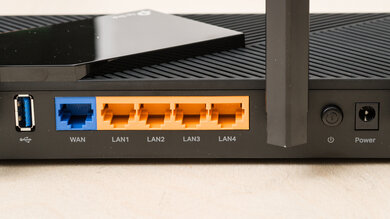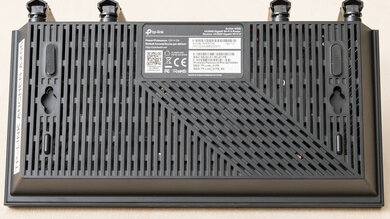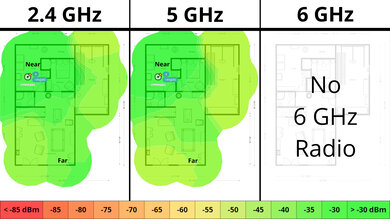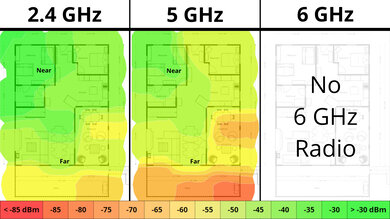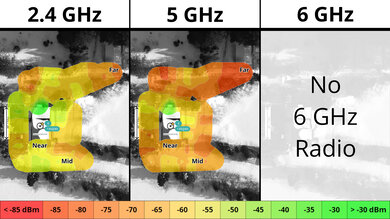The TP-Link Archer AX55 is a dual-band Wi-Fi 6 router with 2.4GHz and 5GHz bands. It supports the 160MHz channel bandwidth on the 5GHz band. It also features a USB 3.0 port, four 1 Gbps LAN ports, and a 1 Gbps WAN port. It supports TP-Link's OneMesh and EasyMesh, so you can add additional access points to create a mesh network.
Our Verdict
The TP-Link Archer AX55 is good if you live in an apartment, condo, or single-story home. It delivers speeds suitable for downloading large files quickly or having multiple users streaming 4k content across a single floor. It also supports Dynamic Frequency Selection (DFS), so it can use less congested DFS-only channels to give you better speeds in noisy wireless environments. It's an average-sized router and has screw head slots on the bottom so you can mount it to a wall or the ceiling.
- Very fast top speeds.
- Wi-Fi 6 doesn't take full advantage of new Wi-Fi 6E or 7 devices.
The TP-Link Archer AX55 is very good if you live in a multi-level house. It has good coverage and delivers fast speeds suitable for high-bandwidth use, like downloading and uploading large files quickly throughout a home with multiple stories. Since it's a standalone router, its speed drops linearly the farther you are from it. Still, since it's compatible with TP-Link's OneMesh and EasyMesh, you can add compatible routers or range extenders to create a mesh network.
- Very good range suitable for single- or multi-level homes.
- Very fast top speeds.
- Compatible with EasyMesh and OneMesh devices to create a mesh network with better range.
- Wi-Fi 6 doesn't take full advantage of new Wi-Fi 6E or 7 devices.
- Standalone router that may have deadzones if you have a very large home.
The TP-Link AX55 delivers very good speeds suitable for an internet connection of up to ~750 Mbps. It also supports Dynamic Frequency Selection (DFS), so it can use less congested DFS-only channels to give you better speeds in noisy wireless environments. That said, it's only Wi-Fi 6, so it doesn't have a faster 6GHz band for your Wi-Fi 6E or 7 devices to take advantage of.
- Very fast top speeds.
- Wi-Fi 6 doesn't take full advantage of new Wi-Fi 6E or 7 devices.
The TP-Link AX55 has a very good range for a standalone router. You can also add a compatible EasyMesh or OneMesh router or range extender to create a mesh network for better range.
- Very good range suitable for single- or multi-level homes.
- Compatible with EasyMesh and OneMesh devices to create a mesh network with better range.
- Wi-Fi 6 doesn't take full advantage of new Wi-Fi 6E or 7 devices.
- Standalone router that may have deadzones if you have a very large home.
Changelog
- Updated Dec 16, 2025: We've added an MLO Implementation test for Test Bench 0.8.2! Read the changelog for more details.
- Updated May 01, 2025: We've converted this review to Test Bench 0.8.1. This includes a new test result for our Test Configuration box.
- Updated Jul 22, 2024: Review published.
Check Price
Differences Between Sizes And Variants
There's a variant of the TP-Link Archer AX55 called the TP-Link Archer AX55 Pro, which has a 2.5 Gbps WAN/LAN port.
Here's a photo of our unit's label.
Popular Router Comparisons
The TP-Link Archer AX55 is a mid-range dual-band Wi-Fi 6 router. It notably supports the 160MHz channel bandwidth on the 5GHz band. Like most current TP-Link Archer routers, it's compatible with TP-Link's OneMesh technology and EasyMesh, so you can easily add more access points.
This router has very good top speeds and range, especially for a standalone router in the lower mid-range price category. It's notably faster than the ASUS RT-AX55 and the NETGEAR Nighthawk RAX30. It's a great choice if you want a solid-performing router and haven't yet upgraded many devices to a newer Wi-Fi standard like Wi-Fi 6E or 7.
The TP-Link Archer AX55 and the GL.iNet Beryl AX (GL-MT3000) are dual-band Wi-Fi 6 routers. The GL.iNet is designed as a travel router, and as such, is considerably smaller. It also runs OpenWRT, an open-source firmware that's more configurable than TP-Link's. The TP-Link, on the other hand, delivers slightly faster top speeds and better range than the GL.iNet. Also, while the latter has a faster, 2.5Gbps WAN port and a 1Gbps LAN port, the former has four 1Gbps LAN ports, so you can connect more devices without buying an external switch.
The TP-Link Archer AX55 and the UniFi Dream Router are dual band Wi-Fi 6 routers. The TP-Link delivers better raw speed and range performance overall, but the UniFi has a much more robust set of features and deep integration with UniFi's ecosystem of networking products.
Test Results

This is a standalone router, so the mesh satellite position line on this graph isn't applicable.
This is a standalone router, so the mesh satellite position line on this graph isn't applicable.


